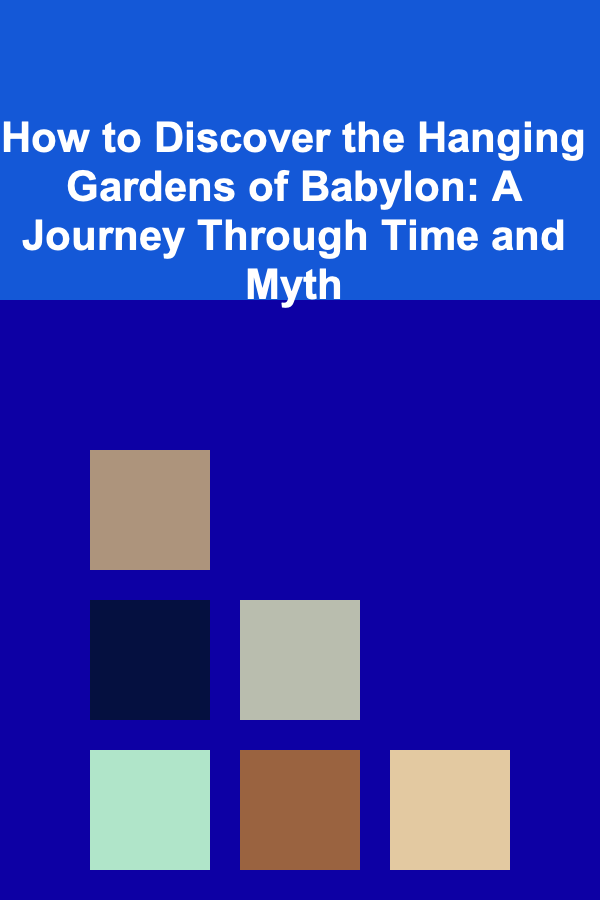
How to Discover the Hanging Gardens of Babylon: A Journey Through Time and Myth
ebook include PDF & Audio bundle (Micro Guide)
$12.99$8.99
Limited Time Offer! Order within the next:

The Hanging Gardens of Babylon, one of the Seven Wonders of the Ancient World, remain one of history's most enduring mysteries. Despite their fame, no physical evidence has been definitively discovered to prove the gardens' existence. Were they a real structure, or are they simply a product of myth and legend? This article explores the historical context, archaeological theories, and ongoing search for the elusive Hanging Gardens, drawing from ancient texts, modern research, and cultural significance.
The Mystique of the Hanging Gardens of Babylon
The Hanging Gardens of Babylon have captivated imaginations for centuries. Often depicted as a magnificent terraced garden built in the ancient city of Babylon, these gardens are said to have been created by King Nebuchadnezzar II around the 6th century BCE, possibly as a tribute to his wife, Amytis of Media. According to historical accounts, the gardens were an extraordinary feat of engineering, with lush vegetation cascading down multi-tiered platforms that seemed to float in mid-air, giving the impression of "hanging" greenery.
Yet, for all the vivid descriptions, the Gardens are not attested by direct archaeological evidence. No definitive ruins or artifacts have been uncovered to confirm their exact location or existence. This leaves us with two main questions: Did the Hanging Gardens truly exist? And if they did, where are they today?
Ancient Accounts of the Hanging Gardens
Our knowledge of the Hanging Gardens comes from a range of ancient texts, but most of the descriptions are secondhand or derived from much later sources. These accounts come from historians, travelers, and scholars who lived centuries after the gardens were believed to have been constructed. Let's examine some of the key ancient sources.
Berossus and the Babylonian Record
The earliest mentions of the Hanging Gardens come from the Babylonian priest and historian Berossus, who wrote in the 3rd century BCE. Berossus is believed to have been the author of Babyloniaca, a history of Babylon that is now lost, though portions of it were quoted by later historians. He refers to the construction of magnificent gardens by King Nebuchadnezzar II for his wife, Amytis. However, Berossus' accounts are largely vague and do not provide specific details on the location or precise nature of the gardens.
Strabo and Pliny the Elder
Another early reference comes from the Greek historian and geographer Strabo (64 BCE -- 24 CE), who mentions the gardens in his Geography. He described them as a series of terraces with plants growing on each level, supported by a sophisticated irrigation system. Strabo's description is one of the most detailed surviving from antiquity, but he also noted that the gardens were no longer in existence during his time.
Pliny the Elder, in his Natural History (first century CE), also provides a brief description of the Hanging Gardens. His account is somewhat less precise than Strabo's, but he agrees with the idea that the gardens were constructed in Babylon by Nebuchadnezzar II. Pliny mentions that the gardens were extraordinary because they were built without visible means of support, implying an advanced engineering technique.
The Myth vs. the Reality
One of the most interesting aspects of the Hanging Gardens is how they blur the line between myth and history. Some scholars believe the gardens may never have existed at all. Others speculate that the descriptions could have been exaggerated, with the gardens being far less impressive than described. It's also possible that the gardens could have been located in a completely different city or under a different ruler's reign.
The idea of "hanging" gardens, particularly as a literal term, seems somewhat contradictory given the climatic conditions of Babylon. The region's arid, hot environment would not have naturally supported such an extensive garden without an advanced irrigation system. In fact, the term "hanging" could be more metaphorical, referring to the cascading nature of the plant life or the terraces that gave the illusion of hanging foliage.
Archaeological Theories and Discoveries
The search for the Hanging Gardens has spurred numerous archaeological investigations, with theories ranging from the identification of Babylon as the garden's location to claims that the gardens were in Nineveh, the capital of the Assyrian Empire. Let's take a closer look at the archaeological evidence and theories surrounding the gardens.
Babylon: The Traditional Location
Babylon, located in modern-day Iraq, is the city most commonly associated with the Hanging Gardens. The city was a major center of ancient Mesopotamian culture and power under the reign of Nebuchadnezzar II. Babylon was famous for its monumental structures, such as the Ishtar Gate and the processional way, which have been excavated and studied by archaeologists.
The ruins of Babylon were first excavated in the 19th century by European archaeologists, but no definitive evidence of the Hanging Gardens has been uncovered in these digs. The most common theory is that the gardens were located near the central palace complex of Nebuchadnezzar. However, the absence of terraced garden features in the remains of the palace complex has left scholars wondering whether the gardens were indeed located here or if the descriptions we have are based on some other structure altogether.
One theory suggests that the gardens may have been located on a man-made mound near the palace, which could have provided the necessary elevation for a terraced structure. However, no remnants of such a mound have been conclusively identified at the Babylonian site.
Nineveh: An Alternative Location
A more recent theory proposes that the Hanging Gardens may have been located in Nineveh, the capital of the Assyrian Empire, rather than in Babylon. This theory was popularized by the 19th-century scholar Austen Henry Layard, who excavated the ruins of Nineveh and found evidence of large, elaborate gardens at the royal palace of King Sennacherib, dating from around 700 BCE.
According to Layard's observations, the gardens at Nineveh were similar in design to the descriptions of the Hanging Gardens, with terraces and a sophisticated irrigation system. The theory posits that the gardens may have been mistakenly attributed to Babylon due to the common association between great wonders and prominent ancient cities. Additionally, the Assyrians' famous expertise in engineering and irrigation would make the creation of such gardens feasible.
However, like the Babylonian theory, the Nineveh location has no direct evidence proving the existence of the Hanging Gardens. There are no detailed accounts from the time of their supposed construction, and Layard's findings could simply be a case of wishful thinking or misinterpretation.
The Role of the Euphrates River
Another significant element in the search for the Hanging Gardens is the role of the Euphrates River, which flows through Babylon and ancient Mesopotamia. Water management systems, including canals, aqueducts, and irrigation techniques, were central to the development of the region's agriculture and city planning. Some scholars believe that the gardens may have been designed around the river, utilizing complex water systems to transport water to elevated terraces.
One potential explanation is that the gardens used an early form of a water-lifting mechanism, like the shaduf or screw pumps, to raise water from the Euphrates to higher levels. This would have allowed for the cultivation of plant life on terraced platforms, giving the illusion of a floating, hanging garden. However, no definitive evidence of such mechanisms has been uncovered in Babylon or Nineveh.
The Search for the Gardens Today
In modern times, the search for the Hanging Gardens continues through both archaeological efforts and scientific advancements. Advances in satellite imagery, ground-penetrating radar, and 3D mapping technology have made it possible to conduct non-invasive surveys of ancient sites, including the ruins of Babylon.
However, the political instability in Iraq has significantly hampered archaeological work in the region. Looting, warfare, and the general lack of funding for archaeological research have further complicated the search for the gardens. Despite these challenges, some hope remains that new technologies and future excavation projects may uncover more conclusive evidence.
International efforts to preserve ancient sites in Iraq, along with increasing global interest in ancient Mesopotamian culture, may eventually shed light on the true nature of the Hanging Gardens. Yet, for now, the question remains: Are they lost to time, or is there still hope of discovering their remains?
Conclusion: The Enduring Legacy of the Hanging Gardens
The search for the Hanging Gardens of Babylon is not just about uncovering ancient ruins---it's a journey into the heart of human creativity, ingenuity, and myth. Whether they existed as described or whether they are simply a product of legend, the gardens hold a timeless allure for historians, archaeologists, and dreamers alike.
Their story is a testament to the rich cultural and technological achievements of the ancient world. Even without definitive proof of their existence, the idea of the Hanging Gardens continues to inspire awe and wonder, reminding us of the endless possibilities that ancient civilizations may have achieved, and the mysteries that still lie buried beneath the sands of time. The quest to discover the Hanging Gardens of Babylon is not just about finding the past---it's about understanding the enduring human desire to create beauty, wonder, and legacy across the ages.

Building Your Client Base as a Successful Financial Advisor
Read More
How to Create a Home Management Binder for Organization
Read More
How to Review and Adjust Your Financial Plan Annually
Read More
The Product Designer's Playbook: Essential Techniques for Building Engaging Products
Read More
How to Plan a Documentary Videography Project: Research & Interviews
Read More
10 Tips for Staying Organized as a Booking Agent
Read MoreOther Products

Building Your Client Base as a Successful Financial Advisor
Read More
How to Create a Home Management Binder for Organization
Read More
How to Review and Adjust Your Financial Plan Annually
Read More
The Product Designer's Playbook: Essential Techniques for Building Engaging Products
Read More
How to Plan a Documentary Videography Project: Research & Interviews
Read More